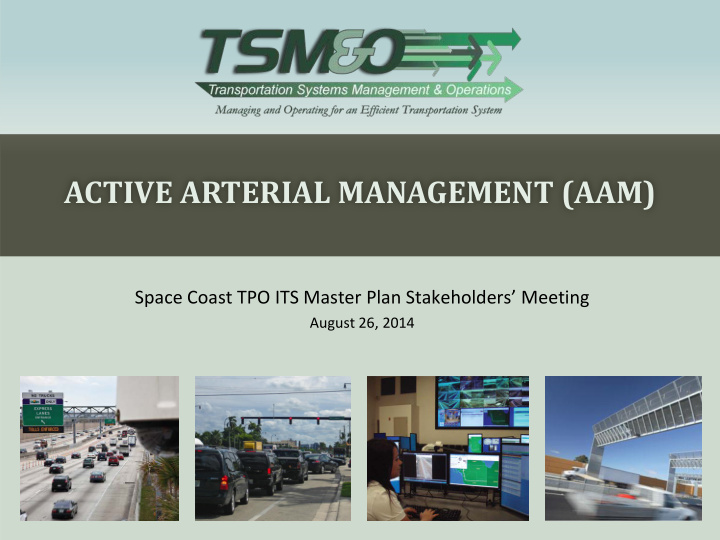



ACTIVE ARTERIAL MANAGEMENT (AAM) Space Coast TPO ITS Master Plan Stakeholders’ Meeting August 26, 2014
BACKGROUND State Arterial Roadways • 32,127 miles • 160,515,000 vehicle miles traveled daily • Current Arterial Problems : Increasing travel time delays • Reduction in travel time reliability • Non-recurring congestion caused by incidents, • special events, and roadway work zones Due to R/W constraints and construction funding, • improvement options are limited 2
BACKGROUND Problem and Contributing Causes • FDOT has a minimal role in the operations and maintenance of the arterial system Local Agencies are responsible for the maintenance • and operations of the Signal Systems which significantly define the efficiency of the arterial system Currently, maintenance agreements (JPA) define the • responsibilities of the agencies The maintenance agreements are NOT tied to • performance measures and lack funding for adequate maintenance or operations All of the above has resulted in a lack of CPR • (Consistent, Predictable, Repeatable) 3
BACKGROUND Active Arterial Management Flowchart 4
SUCCESS IN DISTRICT 4 D4 Arterial Management Program Active Traffic Management (active signal retiming) • Recurring congestion • Non-recurring congestion from incidents (arterial & • freeway) Special Events & Work Zones • Coordination with local responders • Facilitate emergency maintenance needs • Information dissemination • Arterial Dynamic Message Signs • FLATIS (pending) • Palm Beach County – active October 2012 • Broward County – active February 2014 • 5
SUCCESS IN DISTRICT 4 Work Zones FDOT Project #427020-1-52-01 – Okeechobee • Blvd RRR Project Okeechobee Blvd - Jog Rd to I 95 1000 900 800 7:45 – 9:30 Avg. Travel Time 700 Monday Travel Time (sec) 600 Tuesday Before 444 seconds 500 Wednesday 400 During 727 seconds Thursday Friday 300 After 615 seconds Historical 200 100 15% reduction in delay 0 attributable to AAM 6
SUCCESS IN DISTRICT 4 Capital Improvements FDOT Project #42489-2-52-01 – Replacement • of the Flagler Memorial Bridge 7
SUCCESS IN DISTRICT 4 Special Events Palm Beach County Convention Center Convention Center • Queue Detection zones • (300 ft upstream of stop bar) using VDS Special Timing Plan • 35 implemented at three 5 - Left Left-turn Lane 6 - Right Right-Turn Lane 7 -Right-Turn Lane 30 Number of Vehicles Served 25 intersections 20 15 Queue Alarm triggers the 10 • 5 Special Timing Plan when 0 12:00:00 12:05:00 12:10:00 12:15:00 12:20:00 12:25:00 12:30:00 12:35:00 12:40:00 12:45:00 12:50:00 12:55:00 13:00:00 13:05:00 13:10:00 13:15:00 13:20:00 13:25:00 13:30:00 13:35:00 13:40:00 13:45:00 13:50:00 13:55:00 14:00:00 14:05:00 14:10:00 14:15:00 14:20:00 14:25:00 14:30:00 14:35:00 14:40:00 14:45:00 14:50:00 14:55:00 detection zone is occupied Time for 60 seconds 8
SUCCESS IN DISTRICT 4 Performance Measures Monthly Dashboard • Benefits • Delay Savings • Emission Reductions • Fuel Consumption Savings • Safety Benefits • System Health • Device operability • Travel Time Reliability Meas ures • Average Speed • 95 th Percentile Travel Time • Travel Time Index • Buffer Time Index •
BRINGING AAM TO THE SPACE COAST Staffing Requirements Operations • TBD • Maintenance • TBD • Interagency Coordination Manatee County & Sarasota County • Alachua County & City of Gainesville • Palm Beach County & City of Boca Raton • 10
BENEFITS 1. Maximizes the investment that we have already made on the roadways, ports, signal systems, ITS, etc. 2. Economic savings 3. Benefit to Cost Ratio of 16:1 4. Performance Measurement of the Arterial System (Output & Outcome) 5. Reduced delays for ALL travelers 6. Improved travel time reliability 7. Reduced costs of delay to freight and transit 8. Improved real-time management of incidents, special events, or work zones 9. Improved safety based on less stops at signals and reduced secondary crashes 10. Improved environmental factors (reduction of air pollutants) 11
QUESTIONS?
Recommend
More recommend